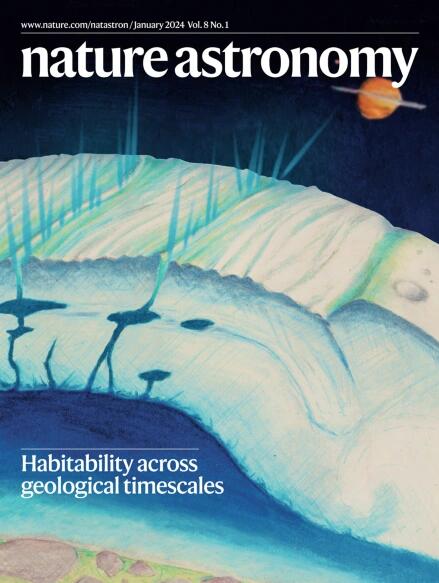通过星系团观测到的活动星系核对轴子样粒子的约束
IF 14.3
1区 物理与天体物理
Q1 ASTRONOMY & ASTROPHYSICS
引用次数: 0
摘要
假设的类轴子粒子(ALPs)之所以引起人们的兴趣,是因为它们有可能充当暗物质,或者揭示尚未发现的物质基本成分的信息。当光子穿过磁场区域时,可能会产生这样的粒子。转换概率取决于磁场参数和光子能量,导致光通过磁化区域时产生几种光谱吸收特征。传统上,天体物理学研究的重点是探测单个物体的这些特征。然而,我们对宇宙磁场特性的有限理解阻碍了研究的进展。本文介绍了一种基于分析星系团背后活动星系核的叠加(而不是单个)光谱的新方法,星系团是一个巨大的磁场储层。叠加有效地平均了磁场中的不确定性,预测了光子到alp转换的明显阶梯状光谱特征。通过这种方法,我们进入了纳米电子伏质量的ALP参数空间以前无法进入的区域。采用这种方法使用来自不同望远镜的数据,并增加堆叠数据集的大小,将显著改善现有的大范围质量边界。切伦科夫望远镜阵列天文台将使这种方法能够探测到一个广泛的参数空间区域,在那里阿尔卑斯山可以作为暗物质。本文章由计算机程序翻译,如有差异,请以英文原文为准。


Constraints on axion-like particles from active galactic nuclei seen through galaxy clusters
Hypothetical axion-like particles (ALPs) are of interest because of their potential to act as dark matter or to reveal information about yet undiscovered fundamental constituents of matter. Such particles may be created when photons traverse regions of magnetic fields. The conversion probability depends on both the magnetic field parameters and the photon energy, leading to several spectral absorption features as light passes through magnetized regions. Traditionally, astrophysical searches have focused on detecting such features in individual objects. However, our limited understanding of the properties of cosmic magnetic fields has hindered progress. Here we introduce a new approach based on analysing the stacked (rather than individual) spectra of active galactic nuclei behind galaxy clusters, which are gigantic magnetic field reservoirs. Stacking efficiently averages over the uncertainties in magnetic fields, predicting a distinct step-like spectral signature of photon-to-ALP conversion. With this approach, we advance into previously inaccessible regions of the ALP parameter space for nano-electronvolt masses. Adopting this method using data from different telescopes and increasing the size of the stacked datasets will significantly improve existing bounds across a wide range of masses. The Cherenkov Telescope Array Observatory will enable this method to probe a broad region of parameter space where ALPs could serve as dark matter. A new method for detecting axion-like particles through stacked spectra of active galactic nucleus–galaxy-cluster pairs probes previously inaccessible regions of their parameter space.
求助全文
通过发布文献求助,成功后即可免费获取论文全文。
去求助
来源期刊

Nature Astronomy
Physics and Astronomy-Astronomy and Astrophysics
CiteScore
19.50
自引率
2.80%
发文量
252
期刊介绍:
Nature Astronomy, the oldest science, has played a significant role in the history of Nature. Throughout the years, pioneering discoveries such as the first quasar, exoplanet, and understanding of spiral nebulae have been reported in the journal. With the introduction of Nature Astronomy, the field now receives expanded coverage, welcoming research in astronomy, astrophysics, and planetary science. The primary objective is to encourage closer collaboration among researchers in these related areas.
Similar to other journals under the Nature brand, Nature Astronomy boasts a devoted team of professional editors, ensuring fairness and rigorous peer-review processes. The journal maintains high standards in copy-editing and production, ensuring timely publication and editorial independence.
In addition to original research, Nature Astronomy publishes a wide range of content, including Comments, Reviews, News and Views, Features, and Correspondence. This diverse collection covers various disciplines within astronomy and includes contributions from a diverse range of voices.
 求助内容:
求助内容: 应助结果提醒方式:
应助结果提醒方式:


